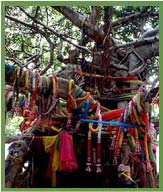
Some fairy tales tell the stories of peasants which become kings or queens. Others tell similar stories, but for the fact that the seeming peasant is, instead, the forgotten/lost/… son/daughter of a royal family. One would think that the first case is more "revolutionary" since it proposes a real social shift. But, in fact, the second one is the real audacious case, because it leads to the conclusion that every peasant could indeed be a king (and, hence, deserves respect).
I have been reminded of this instance while considering the case of plants and their status within Indian culture (see also my previous posts on this subject). Are plants to be respected because of themselves (as independent living beings)? Are they just useful resources (and, hence, to be kept green and strong because of our own advantage)? Do they, lastly, deserve our consideration because of something other than themselves? I include in this last case both the fact that plants may be inhabited by plant deities or that they may be human beings (several fairy tales –both in India and Europe– tell of human beings transformed into plants –in French and Italian there is the well known story of a girl being killed and reborn within a pomegranate). Leaving aside as less morally desirable the second alternative, the third seems less desirable than the first. But is it really so? Thinking at plants as plants may make indulge much more in minor violent acts than thinking at plants as puruṣas (personal living beings, such as Deities or humans).
(I had the pleasure to correspond about plants and Indian (mainly tribal) culture with Prof. Mahendra Kumar Mishra. He also added that not just plants, but also stones are part of the tribal, "integrated" view of life. More on this in a next post.)

No comments:
Post a Comment